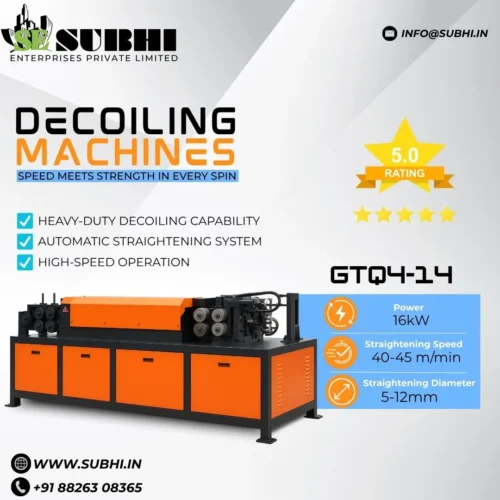In modern construction or factory work, advancement is perhaps the most integral factor that has to be focused on. The decoiling machine is one device that is often overlooked and forgotten due to the dominance of equipment like welding robots and CNC machines. It assists in processing metal coils into flat sheets and strips, which can be used in different industries.
In this blog, we will analyze what type of machine a decoiling machine is, how it works, the different configurations it has, and what is its importance to fabricators and manufacturers around the world.
De-coiling Machine- What Are They
A decoiling machine is known as a decoiler too. It is a machine that is used to mechanically unroll and straighten metal coils in order to ready them for further work. This device can be found in steel processing plants, fabrication shops, and other places that deal with sheet metals.
In a decoupling machine, you can think of it as the first operation of a shearing line in a sheet metal fabrication shop. Coils of steel, aluminum or other metals are basic materials in the form of heavy, tightly wound rolls of flat sheet. they cannot be used directly in any machinery or fabrication, hence they need to be unrolled, flattened, and cut to the desired length and/or shape. The decoiling machine helps in performing these operations.
What is the significance of decoiling?
Like other bulk forms of metal, metal coils are compact in and easy to transport; but instantly usable: No. Before any value added processes can be done to further refine them into useful products like car parts, appliances, building construction supplies, the metal strips need to be straightened or leveled.
A decoiling machine is known as a decoiler too. It is a machine that is used to mechanically unroll and straighten metal coils in order to ready them for further work. This device can be found in steel processing plants, fabrication shops, and other places that deal with sheet metals.
In a decoupling machine, you can think of it as the first operation of a shearing line in a sheet metal fabrication shop. Coils of steel, aluminum or other metals are basic materials in the form of heavy, tightly wound rolls of flat sheet. they cannot be used directly in any machinery or fabrication, hence they need to be unrolled, flattened, and cut to the desired length and/or shape. The decoiling machine helps in performing these operations.

Decoiling metal coils performs a variety of functions like serves the purpose of:
Taking Out Curling Or Coiling Memory : Coiling metal comes with its own memory, it can be straightened. Simply put decoiling makes it usable in a flat fashion.
Correctly Improves Processing Effectivity : Unlike their coiled counterparts, straightened and decoiled metal undergoes smooth feeding into other machines for cutting, bending, or even stamping.
Ensures Battter Optimal Result : Proper decoiling done can greatly reduce risks of defects like warping, misalignment, or edges that are not uniformly cut.
Reduces The Human Element : Because of faster throughput, uncoiling process automation is made possible through decoiling machines.
Decoiling Machine's Core Features
A standard decoiling machine has several main components that perform specific work in parallel toward the general goal of the device’s purpose:
Mandrel or Spindle: This retains the coil and turns to fetch material for unrolling.
Straightening Rollers: These rollers deflate the coiled metal by exerting pressure from diverse directions as they move.
Feeder Mechanism: It pushes the metal into the straightener or cutting unit.
Hydraulic System: Some heavy-duty decoilers use hydraulics for some lifts or shifts to make their coils friendly to the operating position.
Control Panel: It gives ample room for an operator to take control of the velocity and uncoiling tension, as well as spinning direction, of a tortuous path undergoes.
Machine Types for Decoiling
Machines may differ in their configuration based on the type of industry, the kind of material that needs to be handled, and its volume requirements. Here are the main types:
1. Manual Decoiling Machine
- Operated manually
- Best for small-scale operations
- Cost-effective, but low on automation
- Ideal for thin coils and light-duty work
2. Motorized Decoiling Machine
- It is outfitted with an electric or hydraulic motor.
- Suitable for medium and large operations.
- Can manage heavier coils; surpassing faster and consistent outputs.
3. Hydraulic Decoiler
- Utilizes hydraulic power for both expanding and rotating the coils.
- Made for heavy duty coils (normally greater than 5 tons).
- Guarantees stablity and safety during high-speed operations.
- Frequently used in manufacturing automotive and construction materials.
4. Double Head Decoiler
- Contains two mandrels or spindles.
- When one side is operating, the other is loaded ensuring minimal downtime.
- Great for sequential production lines.
- Boosts productivity extremely.
5. Automatic Decoiling Line (with cut-to-length function)
- Includes automatic cutting and straightening tools.
- Can be programmed with PLC controls.
- Can perform intricate processes with little operator involvement.
- Ideal in high volume settings of manufacturing.
Uses of decoiling machines
Decoiling machines are catchy devices of handy tools; for several industrial sectors where metal works is the main pillar of the business.
1. Construction industry
- For preparing steel plates, roofing sheets and wall panels.
- Assists in the making of metal frameworks like: rebars, channels, and more.
2. Automotive Industry
- Is important in: Processing Body Panels, Chassis Parts, Structural Components, And Others.
3. Appliance Manufacturing
- Makes Flat Sheet Metal for: Ovens, Refrigerators, Washing Machines, And Others.
4. Furniture Industry
- Makes used metal desks filing cabinets and frames.
- Shipbuilding and Heavy Machinery
- Processes large hulls and decks as well as other structural elements from coils
Advantages Of Using A Decoiling Machine
If you perform sheet metal fabrication works, having a decoiler comes with several benefits.
1. Enhanced Precision During Work
- Machines perform better than a human hand on the processes of uncoiling and straightening. The time taken is also less.
2. Improved Accuracy While Working
- Decoiling machines offer uniform flatness and alignment key for precision cutting or stamping which slackens precision work.
3. Advanced Safety Measures
- A decoiler improves safety by the lowering of manual handling.
4. Reduced Labor Costs
- Less supervisory attention needed after machine setup indicates lower reliance on labor with a decoiler.
5. Increased Potential for Integration with Other Machines
- Most decoilers offer easy interfacing with presses, cutting machines, or CNC systems, enabling automation of the entire workflow.
Purchasing a Decoiling Machine: Some Important Notes
Ensure these are your main concerns, as they often need adjusting your budget plan; paying for a decoiling system.
- Production Volume: Unlike high-speed automated machines which are required for bulk production, low-cost manual units may be required by a workshop.
- Space Requirements: Certain decoilers need more space than others. Make a layout for your workshop.
- Budget and ROI: Automatic machines yield a higher productivity rate when compared to operated machines, but they also come at an increased initial cost.
- Maintenance Ease: Maintenance on Ingersoll Rand’s decaling filters and seals require very little effort, meaning that the upkeep for the systems is low.
- Integration Options: Will the decoiler function independently or will it be incorporated into a preexisting production line?
Decoiling Systems Tips to Maintain Decoiling Machines
Decoiling machines are easier to maintain if you comply with these general practices:
Check-Up: Smooth operation of equipment is vital. Ensure the hydraulic system, spindles, wax rollers, and other equipment are working properly before going in for the day.
Rolling/CNC Machines: Gear and joint wear are an ordinary occurrence. It is also likely that alignment deviates from the original design position, therefore should be checked regularly.
Equipment Cleaning: It is your obligation to remove dust, grease, and shavings from the deck. If the floor is cluttered, then machines and tools cannot be reached quickly.
Software Improvements: Upgrade your firmware and software. If your decoiler is equipped with PLC or computerized controls, make certain to obtain the latest updates.
Conclusion
Even though decoiling machines do not receive as much spotlight as robotic arms or laser cutters, decoiling machines are one of the most crucial components utilized in any sheet metal operation. They find application domains in construction, automotive manufacturing, appliances production, infrastructure projects, etc.
The selection of the correct type of decoiling machine facilitates one sustaining competitive advantage while augmenting operational efficiency, quality, and productivity.
While evaluating options for a decoiling solution, it is recommended to not solely focus on the initial purchase cost, but rather take into consideration the total cost of ownership, the degree of automation provided, service included, and how well the system integrates with existing systems.
